Bennemann K.H., Ketterson J.B. Superconductivity: Volume 1: Conventional and Unconventional Superconductors; Volume 2: Novel Superconductors
Подождите немного. Документ загружается.


18 Neutron Scattering and the Magnetic Response of Superconductors 1009
Table 18.1.Contributions to M
2
in a ferromagnet and S =
1
2
2D antiferromagnet.
The table illustrates the total moment sum rule
M
2
(
2
B
)
Ferromagnet 2-D S =
1
2
antiferromagnet
Bragg peaks g
2
S
2
(0.061gS)
2
=0.37
Spin waves g
2
S 1.7
Multi-magnon 0 0.93
Total g
2
S(S +1) 3
(ii) one-magnon excitations and (iii) multimagnon
excitations. The sum of these contributions is gov-
erned by the moment sum rule (Eq.18.12).Table18.1
summarizes the spectral weights of the these contri-
butions as determined from a 1/S expansion the-
ory [88].
Linear Spin-Wave Theory for Nearest Neighbour
Interactions
The coupling between neighbouring spins in a
square-lattice antiferromagnet is described by the
Heisenberg Hamiltonian,
H =
ij
J S
i
· S
j
. (18.16)
Conventional spin-wave theory of the Holstein–
Primakoff type, in the classical large-S limit, yields
the transverse dynamic susceptibility
⊥
(Q, !)=Z
d
(!)
2
g
2
2
B
S
1− (Q)
1+ (Q)
1/2
× ı
(
! ±!(Q)
)
, (18.17)
where,
!(Q)=2Z
c
J
1−
2
(Q)
1/2
, (18.18)
and (Q)=
1
2
[
cos(2h) + cos(2k)
]
.Wehavein-
cluded a “quantum renormalisation” of the overall
spin-wave amplitude Z
d
(!)(ifZ
c
is constant then
Z
d
= Z
/Z
c
). For the conventional linear spin-wave
model applicable for large S, Z
d
(!)=1.Inorder
to make comparisons with neutron scattering and
nuclear resonance experiments, it is useful to cal-
culate the“local” or“wavevector-integrated”energy-
dependent susceptibility
(!) defined by Eq. 18.7.
In the low frequency limit Eq. 18.17 yields,
⊥
(!)=
Z
d
(!)g
2
2
B
S
2Z
c
J
. (18.19)
Magn etic Excitations in La
2
CuO
4
Early measurements were performed on a conven-
tional reactor source using an “energy integrating”
technique [89,90] in which the two-dimensionality
of the magnetic interactions was exploited and the
magnetic response was integrated in energy up to
about 30 meV. This method allowed the weak signal
to be seen in relatively small single crystals. The spin
fluctuations were shown to have a wide energy scale
(> 10 meV).
Subsequent experiments were performed using
epithermal neutrons produced by the “hot” source
at the Institute Laue–Langevin. The use of the
hot source allowed the spin-wave dispersion to be
followed up to 140 meV and the two counter-
propagating branches to be resolved [91, 92]. At
T=5 K, the spin-wave velocity was found to be
v
s
=0.85 ± 0.03 eV Å. Using the low-frequency
limit of Eq. 18.18, v
s
= Z
c
√
8SJa and assuming
Z
c
=1.18 [88,93] yields a Heisenberg coupling con-
stant J = 136 ± 5 meV. In spite of the use of the
hot source and 0.1 kg of aligned single crystal, the
highest energy which could be achieved by reactor-
based three-axis methods was about 140 meV. Spal-
lation sources offer low background and high inci-
dent energies. The use of chopper spectrometers at
the ISIS spallation source allowed the zone bound-
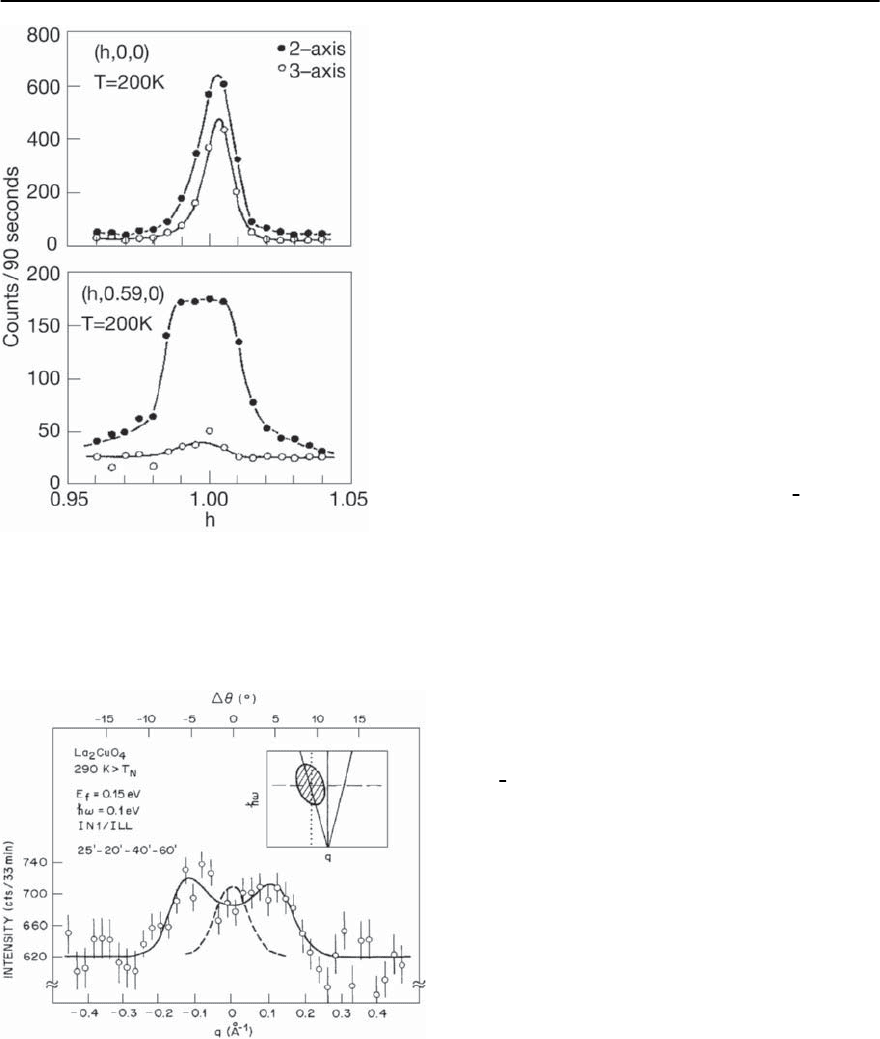
1010 S.M. Hayden
Fig. 18.19. Spin wave excitations in La
2
CuO
4
. Open circles
are scans with an energy window of about 1 meV around
zero. Closed circles correspond to an energy integration of
about 10 meV. The lower f igure demonstrates the existence
of magnetic excitations with an energy scale greater than
the integration window. After Shirane et al. [90]
Fig. 18.20. Hot source measurements of spin waves
in La
2
CuO
4
. The figure shows two resolved counter-
propagating spin waves. After Aeppli et al. [91]
ary single-magnon excitation to be measured [94].
The value of J determined from this early ISIS ex-
periment was J = 132 ± 4 meV. Improvements in
the ISIS instrumentation led to a considerable in-
crease in the wavevector resolution of which allowed
a subsequent measurement to resolve the detailed
dispersion throughout the Brillouin zone.
The linear spin-wave theory for a 2D square lattice
antiferromagnet (2DAF) with nearest neighbour in-
teractions described in the previous section predicts
that there is no dispersion in the magnon excita-
tions around the antiferromagnetic Brillouin zone
boundary, for example, along the line connecting
Q = (1/2,0) and (1/4,1/4) or (3/4,1/4). This lack of
dispersion is illustrated in Fig. 18.18. The measured
magnon dispersion in La
2
CuO
4
isshownin Fig.18.21.
In fact the magnon in La
2
CuO
4
shows a 7.5 % in-
crease in energy between (3/4,1/4) [or (1/4,1/4)] and
(1/2,0)[95].Adeviationof6%intheoppositesense
is observed in the another model S =
1
2
2D anti-
ferromagnet, Cu(DCOO)
2
· 4H
2
0 [96]. Two possible
explanations of the observed deviations have been
proposed. The first is that low-order spin wave the-
ory fails to account for the high energy dynamics
of the Heisenberg model because of the quantum
fluctuations inherently present in the ground state
of the 2D Heisenberg model [97–100]. The second
is that a nearest-neighbour Heisenberg Hamiltonian
does not describe La
2
CuO
4
and higher order ex-
change terms such as cyclic exchange are required
to describe La
2
CuO
4
. Monte Carlo simulations of a
S =
1
2
2D Heisenberg model [98, 99] suggest a 10
% decrease in the magnon energy between (1/4,1/4)
and (1/2,0), the opposite to experiment.Thus the ob-
served magnon dispersion must be largely due to
longer range exchange interactions.
The exchange coupling constant J has been dis-
cussed widely in the literature (see, for example
[101]). Our understanding is based on Anderson’s
theory of superexchange [102] in which J ≈ 4t
2
/U.
Theoverlapofthecopperd orbitals and the oxygen
p orbitals is characterized by the hopping parame-
ter t and U represents the on-site interaction (in the
oxygen orbital). Fig. 18.13 illustrates the valence or-
bitals for a Cu
4
O
4
plaquette in La
2
CuO
4
. The large
orbital hybridizationin the CuO
2
planes provides an
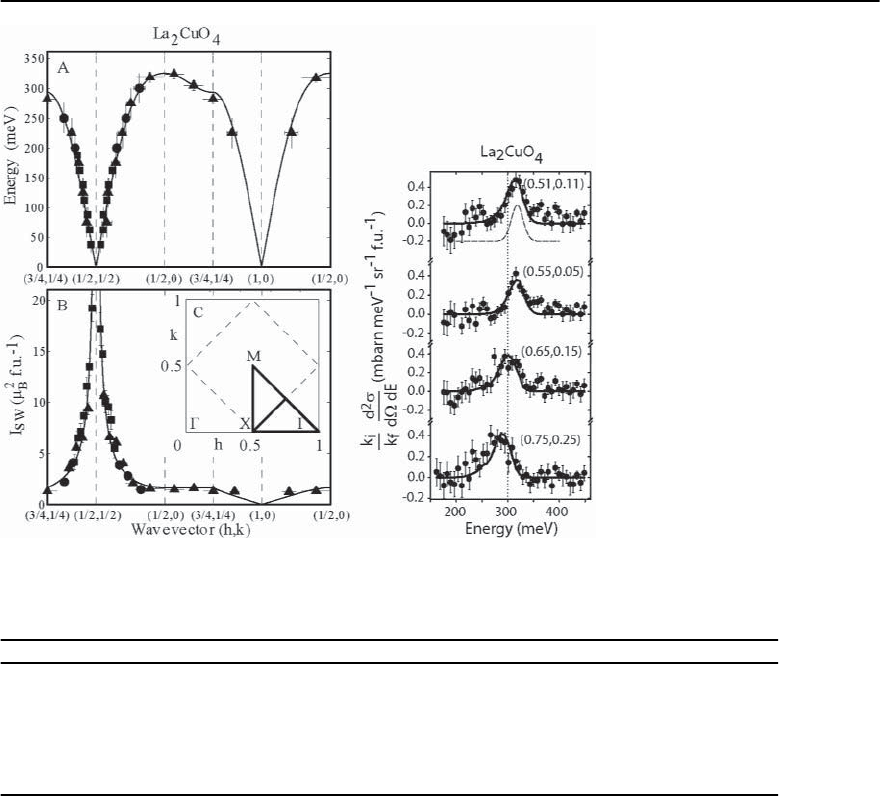
18 Neutron Scattering and the Magnetic Response of Superconductors 1011
Fig. 18.21. Left:Spinwavedis-
persion of La
2
CuO
4
. Right :Zone
boundary spin waves (after [95])
Table 18.2.Experimentally determined exchange constants for antiferromagnetic La
2
CuO
4
and related compounds. J has
been corrected for the effect of quantum fluctuations which are expected to renormalise the bare exchange constants
J
∗
= Z
c
J,withZ
c
≈ 1.18 (see Sect. 18.6.2).
Composition Ref. T(K) J
(meV) J
c
(meV)
La
2
CuO
4
Aeppli et al. [91] 290 136 ± 5
La
2
CuO
4
Hayden et al. [94] 296 132 ± 4
La
2
CuO
4
Coldea et al.[95] 295 138 ± 438±8
La
2
CuO
4
Coldea et al.[95] 10 146 ± 461±8
Nd
2
CuO
4
Bourges et al. [103] 17 155 ± 3
Pr
2
CuO
4
Bourges et al. [103] 18 121 ± 3
exchange path to include all four spins at the cor-
ners of elementary Cu
4
O
4
plaquettes. Second near-
est neighbour Heisenberg exchange paths are also
possible. Measurements of the magnon dispersion
cannot distinguish between next-nearest neighbour
two-spin exchange and cyclic exchange terms of the
form [95]
H = J
c
i,j,k,l
=
(S
i
·S
j
)(S
k
· S
l
)
+(S
i
·S
l
)(S
k
·S
j
)−(S
i
· S
k
)(S
j
· S
l
)
>
, (18.20)
where the spins are labelled clockwise around a
Cu
4
O
4
square plaquette.
A one-band Hubbard model provides a natural
understanding of the observed spin wave dispersion
for La
2
CuO
4
in terms of the Hubbard parameters t
and U. If hopping is included up to order t
4
(i.e.
four hops), a fit to the observed dispersion yields
the values t =0.33 eV and U =2.9 eV [95]. The fact
that higher order exchange terms are required to de-
scribe the dispersion relation in La
2
CuO
4
suggests
that longer range exchange interactions may also be
important in doped and superconducting composi-
tions.
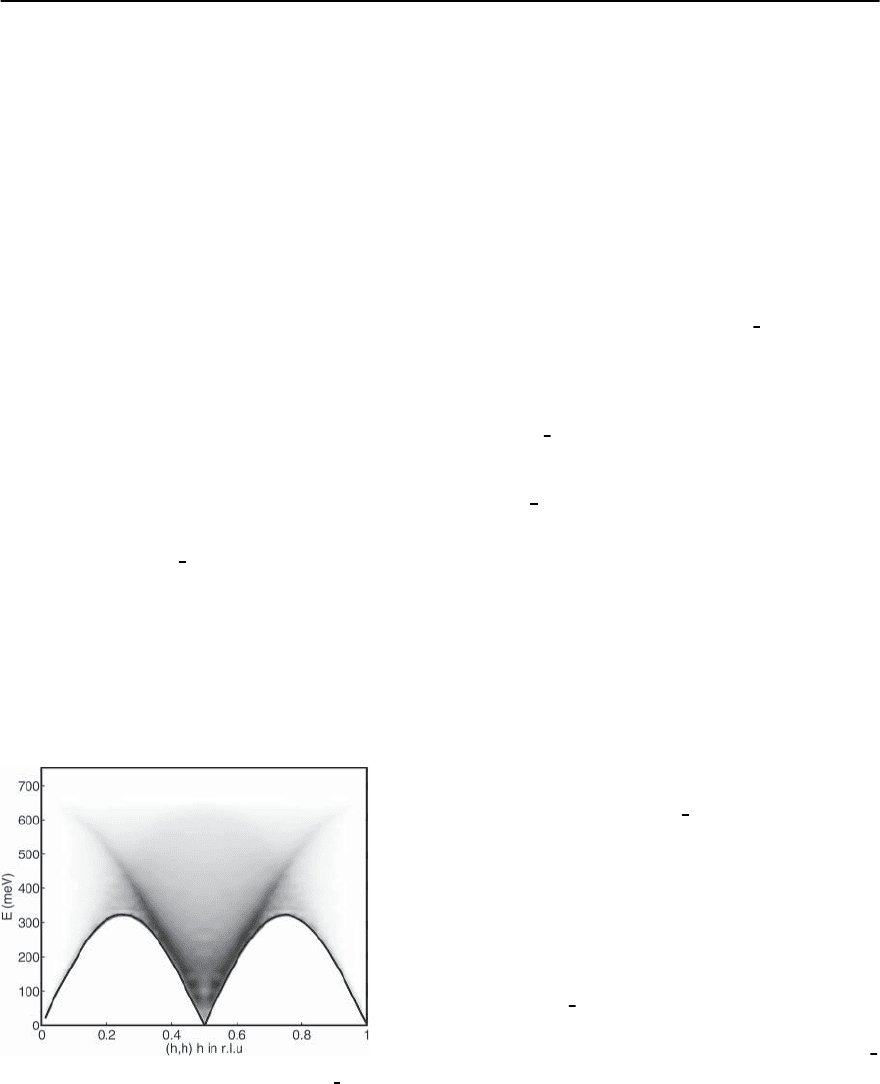
1012 S.M. Hayden
Multi-Magnon Excitations
A Heisenberg ferromagnet has two interesting prop-
erties not shared by the Heisenberg antiferromagnet.
The fully aligned ferromagnetic state is the ground
state (and an eigenstate) of the Hamiltonian. In ad-
dition, spin wave states are also eigenstates of the
Hamiltonian. In contrast,the Neel state (in which the
moments on each site do not fluctuate with time) is
not the ground state an antiferromagnetic Heisen-
berg Hamiltonian. For small S, quantum fluctua-
tions [88] become important. Quantum fluctuations
lead to a number of effects: (i) a reduction of the
ordered moment; (ii) renormalisation of the spin-
wave energies and intensities; (iii) the existence of
multi-magnon excitations. Thus, in addition to the
single-magnon modes, two-magnon excitations give
rise to a continuum, as a function of energy, in the
longitudinal response
zz
(q, !), and three-magnon
excitations results in side bands (to the one-magnon
excitations) in the transverse response
⊥
(q, !).Fig-
ure 18.22 shows a calculation of the two-magnon re-
sponse for a 2D S =
1
2
square lattice antiferromag-
net [104,105].
Quantum effects lead to the renormalisation of
the (one-magnon) spin-wave dispersion, the perpen-
dicular susceptibility,the spin-stiffness constant,and
the sub-lattice magnetization with respect to clas-
sical (large-S) spin-wave theory. These renormalisa-
tion factors havebeen estimatedby a number of tech-
Fig. 18.22. Two-magnon excitations in a S =
1
2
square lat-
tice antiferromagnet. Calculation details are given in [104]
and [105]
niques. For the purpose of comparing theory and ex-
periment in the present review,we include the renor-
malisation of the overall energy scale in the exchange
constant, J
∗
= Z
c
J,whereJ is the “bare” exchange
constant occurring in Eq. 18.16. We have previously
defined the renormalisation of the amplitude of the
magnetic response in Eq.18.17.We note that,in prin-
ciple, these factors are energy dependent. The value
of Z
d
(!) can be obtained from neutron scattering,
if measurements are placed on an absolute intensity
scale. However, Z
c
cannot be measured directly from
inelastic neutron scattering and must be estimated
from theory. In the case of the S =
1
2
square-lattice
antiferromagnet, Singh [88] has estimated Z
c
=1.18
and Z
d
(! = 0)=0.61.
The 2D S =
1
2
Antiferromagnet at Finite Temperatures
Since the 1950s, it has been widely believed that the
2D S =
1
2
square-lattice antiferromagnet has long
range order only at T = 0.Anderson [85],argued that
eventhrough the staggered magnetization may be re-
duced, the N´eel state is still stable against quantum
fluctuations at T = 0. Anderson’s assertion means
that this model system is an example of a “quantum
critical”phase transition i.e.one which occurs at zero
temperature and is therefore dominated by quantum,
ratherthan classical,fluctuationsin theorder param-
eter. It was not surprising that the discovery of the
antiferromagnetism in La
2
CuO
4
and related com-
pounds rejuvenated theoretical [93,106–108] and ex-
perimental [89] interest in this problem. The liter-
ature devoted to the S =
1
2
square-lattice antifer-
romagnet is now vast, indeed there are several re-
views [107] on this subject.
One of the novel features of low dimensional an-
tiferromagnets,in particular 2D antiferromagnets,is
the strong build up of “critical” magnetic fluctua-
tions at temperatures considerably above the order-
ing temperature. This behaviour is not at all con-
fined to S =
1
2
(see, for example, the review by De
Jongh and Miedema [109]). Figure 18.23 illustrates
the magnetic excitation spectrum for a 2D S =
1
2
antiferromagnet at finite temperature. For small fre-
quencies and wavevectors, propagating excitations
are believed not to exist, instead the response is
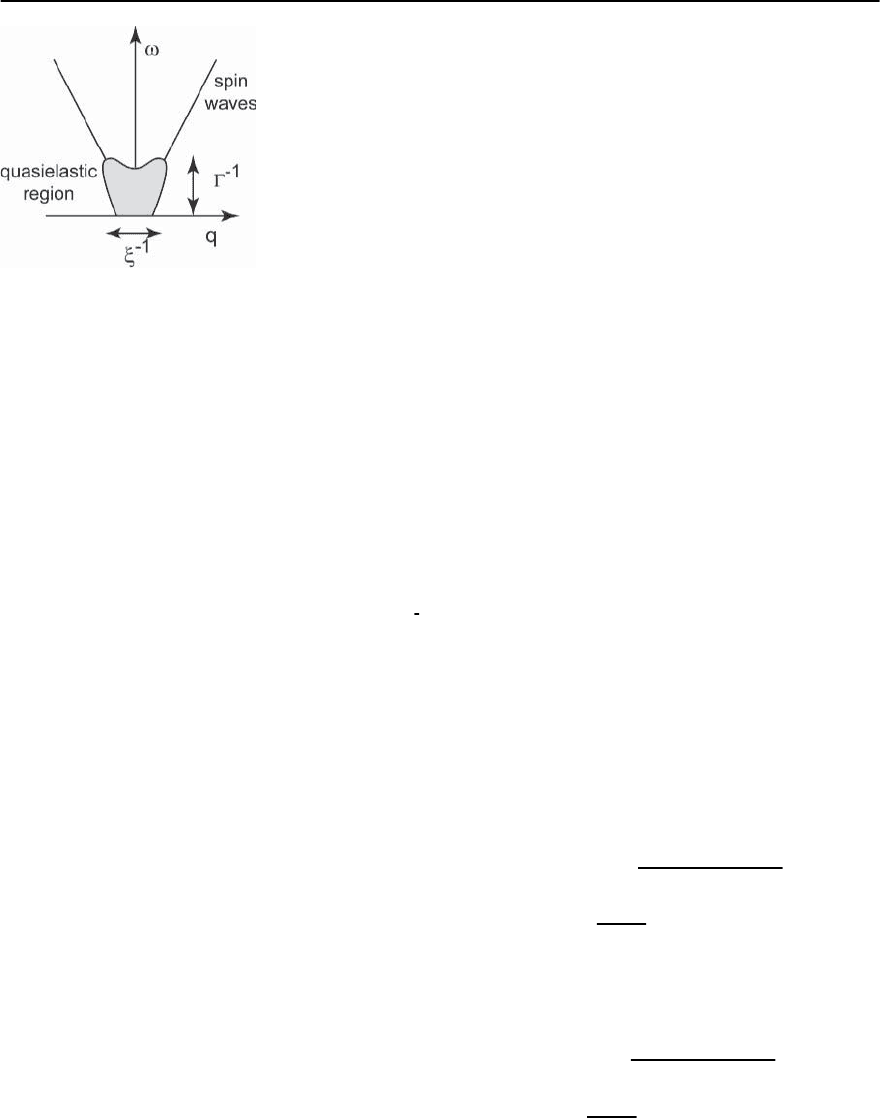
18 Neutron Scattering and the Magnetic Response of Superconductors 1013
Fig. 18.23. Schematic representation of the magnetic re-
sponse in a 2D antiferromagnet at finite temperature
dominated is a ‘quasielastic peak’ (i.e.
(q, !)/!
is peaked at zero frequency). Since this peak domi-
nates the response for wavevectors near the ordering
wavevector, its width in wavevector is usually char-
acterized by the inverse correlation length
−1
ob-
tained from the width of S(Q), the Fourier transform
of the equal-time correlation function.In the regime
! v
s
−1
(v
s
is the spin-wave velocity) spin-wave
interactions are the main mechanism for damping.
Grempel [110] estimated the order-parameter re-
laxation rate for q = 0 using a coupled-mode cal-
culation and found that
2
v
s
−1
(T/2
s
)
1
2
.
Chakravarty et al. [93, 106] have obtained defini-
tive results for the low-frequency response. They
showed that the long-wavelength, low-energy prop-
erties were well described by a mapping to a classical
two-dimensional Heisenberg magnet. The effects of
quantum fluctuationsare absorbed intothe coupling
constants. Using this approach and Monte Carlo sim-
ulationstheyfoundthatthe temperaturedependence
of the correlation length is,
= C
a exp
2
s
/k
B
T
. (18.21)
At energies larger than a few v
s
−1
,propagating
spin waves should exist and the response is believed
to be essentially as for T =0,exceptthatwemust
average the direction of the antiferromagnetic mo-
ment. The high frequency magnetic excitations see
the moment in the “quasielastic peak” as frozen do-
mains of size .
Magn etic Excitations in Antiferromagnetic YBa
2
Cu
3
O
6
YBa
2
Cu
3
O
6
is made up of pairs of CuO
2
planes, these
‘bilayers’ are then stacked together. Band structure
calculations [111, 112] suggest that there is a mod-
est electronic coupling between neighbouring Cu
atoms in different planes of the bilayer. This leads
to a inter-planar hopping parameter t
⊥
≈ 0.3 eV .
The resulting bilayer splitting in the band struc-
ture has been observed by angle-resolved photoe-
mission spectroscopy (ARPES) [74] in the related bi-
layer high-T
c
system Bi
2
Sr
2
CaCu
2
O
8+ı
. The electron
coupling between the two planes which make up the
bilayer also results in an inter planar exchange cou-
pling J
⊥
. The structure of the tetragonal insulating
phase of YBa
2
Cu
3
O
6
and the largest exchange cou-
plings are illustrated in Fig.18.14.Inorder toaccount
for the exchange coupling between Cu spins in dif-
ferent layers we add a second term to Eq. 18.16,
H =
ij
J
S
i
·S
j
+
ij
J
⊥
S
i
· S
j
. (18.22)
The presence of the second term (i.e. J
⊥
=0)in
Eq.18.16leads to the existence of two branches in the
spin-wave dispersion which can be labelled accord-
ingto whether neighbouring spinsin different planes
precess out-of-phase (“acoustic” or “odd” mode) or
in-phase (“optical”or“even”mode) abouttheir time-
averaged (ordered) directions. In the conventional
linear spin-wave approximation,the acoustic and op-
tic modes have the response functions per formula
unit [6]
odd
(Q, !) = (18.23)
Z
d
g
2
2
B
S
1− (Q)+J
⊥
/2J
1+ (Q)
1/2
× sin
2
zl
c
ı
(
! ±!
odd
(Q)
)
and
even
(Q, !) = (18.24)
Z
d
g
2
2
B
S
1− (Q)
1+ (Q)+J
⊥
/2J
1/2
×cos
2
zl
c
ı
(
! ± !
even
(Q)
)
,

1014 S.M. Hayden
Fig. 18.24. Left:Constant
energy scans showing the
spin waves in YBa
2
Cu
3
O
6.15
.
Scans (b)–(e) are chosen
to emphasize the acous-
tic mode and scans (g)–
(i) to emphasize the op-
tical mode. The onset of
scattering for the optical
(even) mode is at about 74
meV. Right: The spin wave
dispersion in YBa
2
Cu
3
O
6.15
:
acoustic branch (closed cir-
cles, solid line),optic branch
(open circles, dashed line).
(After Hayden et al.) [116]
Table 18.3. Experimentally determined exchange constants for antiferromagnetic YBa
2
Cu
3
O
6+x
. No corrections have been
made for the effect of quantum fluctuations which are expected to renormalise the bare exchange constants J
∗
= Z
c
J,
with Z
c
≈ 1.18 (see Sect. 18.6.2).
Composition Ref. J
∗
(meV) J
∗
⊥
(meV) Z
d
!
g
(meV)
YBa
2
Cu
3
O
6.2
[114] 120 ± 20 > 8
YBa
2
Cu
3
O
6.2
[115] 10 67 ±5
YBa
2
Cu
3
O
6.15
[116] 125 ± 511±20.4 ± 0.174±5
PrBa
2
Cu
3
O
6.2
[117] 127 ± 10
respectively. The dispersion relations are
!
odd
(Q)=2Z
c
J
×
=
1−
2
(Q)
+ J
⊥
/J
1+ (Q)
>
1/2
!
even
(Q)=2Z
c
J
×
=
1−
2
(Q)
+ J
⊥
/J
1− (Q)
>
1/2
, (18.25)
where (Q)=
1
2
[cos(2h)+cos(2k)] and z=3.2Å
is the separation of the CuO
2
planes in a bilayer.
The inter-planar coupling term in Eq. 18.22 leads
to no additional dispersion along the z-direction,
only a modulation in the amplitude of the response
which nevertheless can be used to distinguish be-
tween the two modes. Thus the bilayer nature of this
YBa
2
Cu
3
O
6+x
results in two collective modes with
additional structure to
(q, !)ascomparedwith
the single layer material. The even or optic mode
has a gap at the 2D magnetic zone centres such as
(
1
2
1
2
l)of!
g
=2
J
∗
⊥
J
∗
. Its intensity displays an
overall modulation cos
2
(zl/c) which has max-
ima at positions l =0, 3.7, 7.3,.... Correspondingly,
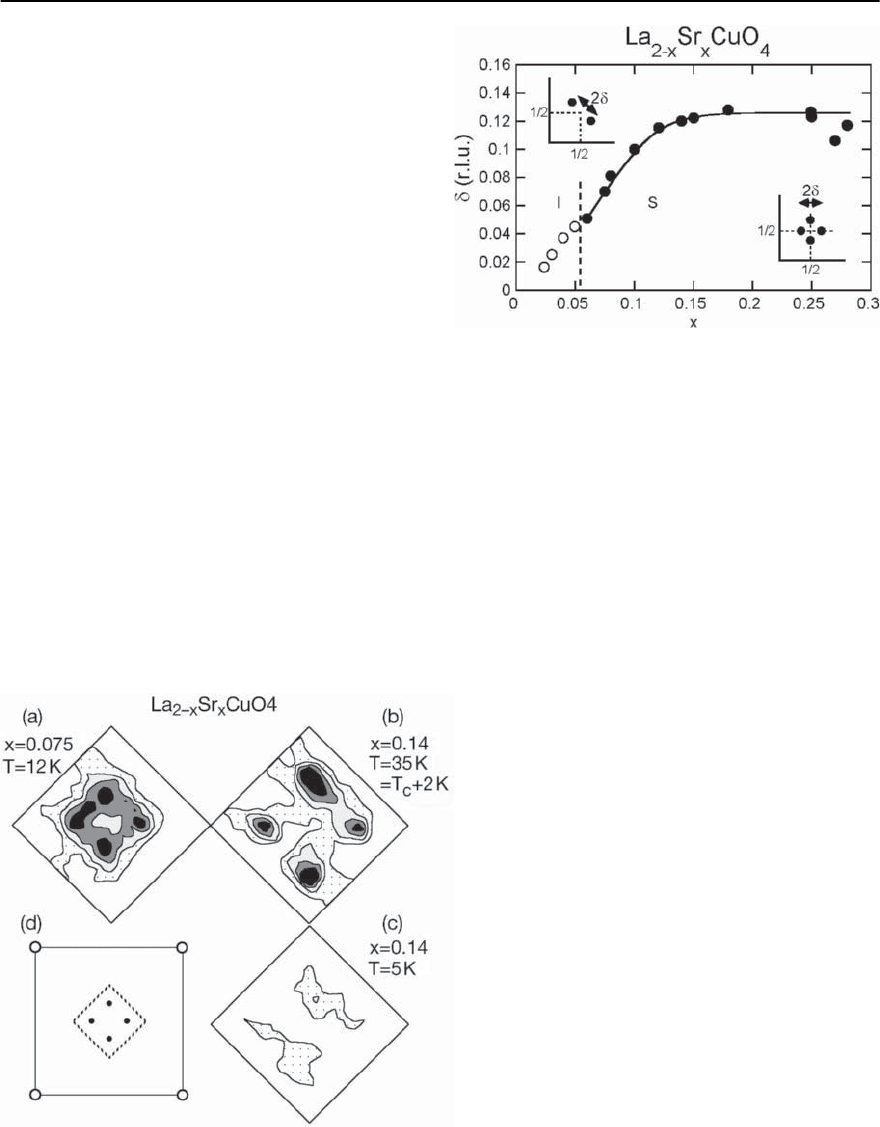
18 Neutron Scattering and the Magnetic Response of Superconductors 1015
the even or acoustic mode has an overall modulation
of sin
2
(zl/c) and therefore has maxima at l =
1.8, 5.5,....
There have been several studies of the spin
waves in strongly underdoped antiferromagnetic
YBa
2
Cu
3
O
6+x
[6,113–116]. Measurements made with
thermal neutronsat a reactor source by Shamoto and
co-workers [114] were able to resolve the acoustic
branches of the spin waves and estimate an exchange
constant coupling ofJ
∗
=120±20 meV.Higher energy
measurements were carried out by Reznik et al.[115]
and Hayden et al. [116] using hot neutrons at a reac-
tor source and spallation neutrons, they were able to
observe gaps in the optic (even) excitations of 67 ±5
meV and 74 ±5 respectively. Hayden et al.[116] also
showed that the magnetic excitations persisted up
to 275 meV and that the intensity of the spin wave
excitations is strongly renormalised due to quantum
fluctuations (see Sect. 18.6.2) with Z
d
=0.4 ± 0.1.
18.6.3 Magnetic Excitations in La
2−x
Sr
x
CuO
4
Sr or Ba doping of La
2
CuO
4
causes the long range
antiferromagnetic Neel order to be replaced with a
frozen spin state at low temperatures. As discussed
above, this state has some of the characteristics of
Fig. 18.25. The doping dependence of the incommensu-
rability ı of the low frequency magnetic excitations in
La
2−x
Sr
x
CuO
4
. Closed circles refer to the superconducting
or metallic state. Open circles refer to the incommensurate
order observed for lightly doped insulating compositions.
Data collected from [57,69,119,120]
a spin glass and is suppressed by optimal doping.
Thurston et al. [118] found that the low energy mag-
netic response of La
2−x
Sr
x
CuO
4
showed incommen-
surate peaks at finite frequencies near the (1/2,1/2)
position. The location of these peaks was identified
as (1/2 ± ı, 1/2) and (1/2, 1/2 ± ı)byCheonget
al. [119] for samples with x =0.075 and x =0.14.
Fig. 18.26. Low energy magnetic excitations in
La
2−x
Sr
x
CuO
4
.(a) x =0.075 and ! =1meVand
T = 12 K (after Cheong et al. [119]). (b)–(c) x =0.14
and ! =2meVforT above (b) and below T
c
(c). No-
tice how superconductivity suppresses the low energy
response
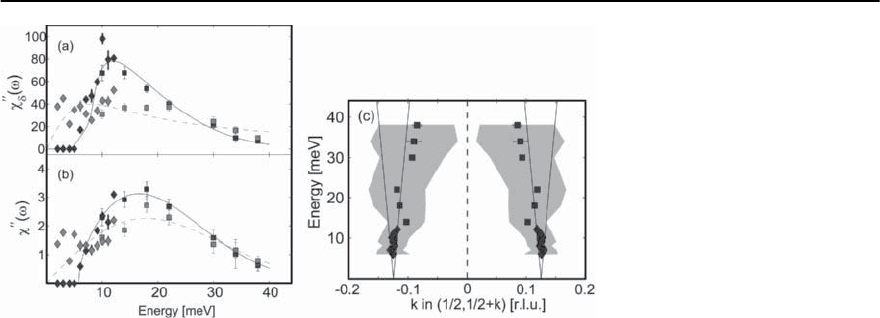
1016 S.M. Hayden
Fig. 18.27. Measurements of the low energy incommensurate magnetic excitations in La
1.84
Sr
0.16
CuO
4
.(a)Energyde-
pendence of
ı
(!), the fitted peak intensity of
(q, !) at the incommensurate peak position Q
ı
. Superconducting
phase, filled symbols; normal phase, open symbols. MAPS data, squares; triple-axis data, diamonds.(b) Local suscepti-
bility
(!). (c) Dispersion of the excitations in LSCO. Shaded regions represent the fitted FWHM. Solid lines show the
spin-wave velocity of La
2
CuO
4
with J
∗
= 156 meV. Open circle: YBCO6.6. (After N.B. Christensen et al.[124])
The variationof the incommensuratewavevector has
been studied systematically with doping by Yamada
and co-workers [57,69,120]. The incommensurabil-
ity increases up to about ı =0.12 and then satu-
rates (see Fig. 18.25). The incommensurate fluctua-
tions condense out near the x =1/8composition
to give incommensurate static order. This coincides
with a plateau in T
c
versus doping in La
2−x
Sr
x
CuO
4
and a marked dip in T
c
(x)inLa
2−x
Ba
x
CuO
4
.Another
interesting featureof the low-energy spin excitations
is that they are strongly temperature dependent. As
the temperature is lowered towards T
c
the intensity
of the low-energy incommensurate peaks increases
and the width in wavevector decreases [121]. Thus
it is clear that the incommensurate fluctuations are
close to condensing and that they can be made to
condense near the x =1/8composition.Tranquada
et al. [73] have demonstrated that superconductiv-
ity can be completely destroyed and incommensu-
rate static spin and charge density waves induced
by substituting Nd for La in La
1.6−x
Nd
0.4
Sr
x
CuO
4
.
However it should be noted that this composition
has a different crystallographic structure to LTO
structure of La
2−x
Sr
x
CuO
4
. The low energy incom-
mensurate excitationsin La
2−x
(Ba,Sr)
x
CuO
4
broaden
and disperse with increasing energy [122–124]. Fig-
ure 18.27 shows the recent data of Christensen et
al. [124] which clearly demonstrate inward disper-
sion towards (1/2,1/2).
High Energy Response
The high-energy magnetic response in La
2−x
Sr
x
CuO
4
near optimal doping has been studied by spallation
neutrons [125]: some of the results of this study are
shown in Figs. 18.28 and 18.29. It is found that mag-
netic excitationspersist up to 200–300meV,although
they are much weaker and broader in Q-space than
for the parent insulator La
2
CuO
4
. Surprisingly the
lower energy excitations are stronger in the super-
conductor than the insulator when the response is
integrated over wavevector to yield the local suscep-
tibility
(!). Thus the characteristic energy scale
of the spin fluctuations is lowered by doping (at least
up to x ≈ 0.14).
Superconducting State
Clearly we would expect the low energy magnetic
response to be suppressed on entering the super-
conducting state as other techniques such as NMR
which probe the spin susceptibility in the supercon-
ducting state show a strong reduction. Early work
on La
2−x
Sr
x
CuO
4
showed that the suppression of the
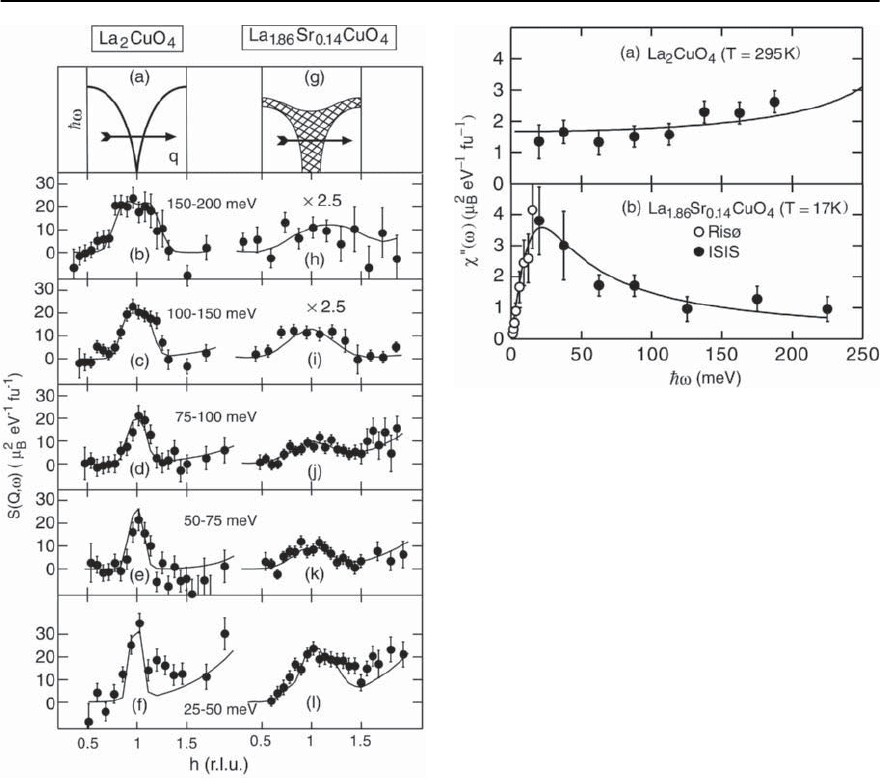
18 Neutron Scattering and the Magnetic Response of Superconductors 1017
Fig. 18.28. A comparison of the magnetic excitations in in-
sulating antiferromagnetic La
2
CuO
4
and superconducting
La
1.86
Sr
0.14
CuO
4
. (After Hayden et al. [125])
magnetic response in the superconducting state is
dependent on sample quality [119,126–130]. In clean
samples, a suppression of the magnetic response is
observed below about 7 meV for samples near op-
timal doping [124,127–130] with the lower energy
incommensurate excitations being completely sup-
pressed within the experimental error.At higher en-
ergies the incommensurate magnetic response is en-
hanced on entering the superconducting state [124,
129, 130]. Entering the superconducting state also
causes the magnetic response to become sharper in
Fig. 18.29. The local susceptibility for insulating antiferro-
magnetic La
2
CuO
4
and superconducting La
1.86
Sr
0.14
CuO
4
.
Doping leads to a suppression of the integrated spectral
weight at higher energies.However,the integrated response
at lower energies, ! ≈ 15 meV, is larger in the supercon-
ductor than the insulator. (After Hayden et al.[125])
wavevector [129,130]. For optimally doped samples
the greatest enhancement occurs at about 15 meV
[124]. Fig. 18.27 shows data from Christensen et al.
[124] illustrating these effects.
18.6.4 Magnetic Excitations in YBa
2
Cu
3
O
6+x
The bilayer structure of YBa
2
Cu
3
O
6+x
complicates
both the measurement and interpretation of the spin
excitations with respect to the La
2−x
Sr
x
CuO
4
system.
Asdiscussedin Sect.18.6.2,the bilayer structureleads
to two types of magnetic excitation (odd and even) in
which corresponding spins in neighbouring bilayers
precess in-phase or out-of-phase. Separating the two
types of excitation requires the choice of particular
components of momentum parallel to c
∗
(l values).
This places kinematic constrains on the scattering
experiment.
The most obvious feature of the magnetic re-
sponse in YBa
2
Cu
3
O
6+x
is the so-called resonance
peak [10,132,133] in
(q, !) which occurs at Q
2D
=
(1/2,1/2) in the odd channel and at an energy of
41 meV for optimal doping. The resonance develops
near T
c
at optimally doping [10,133]. Figure 18.30
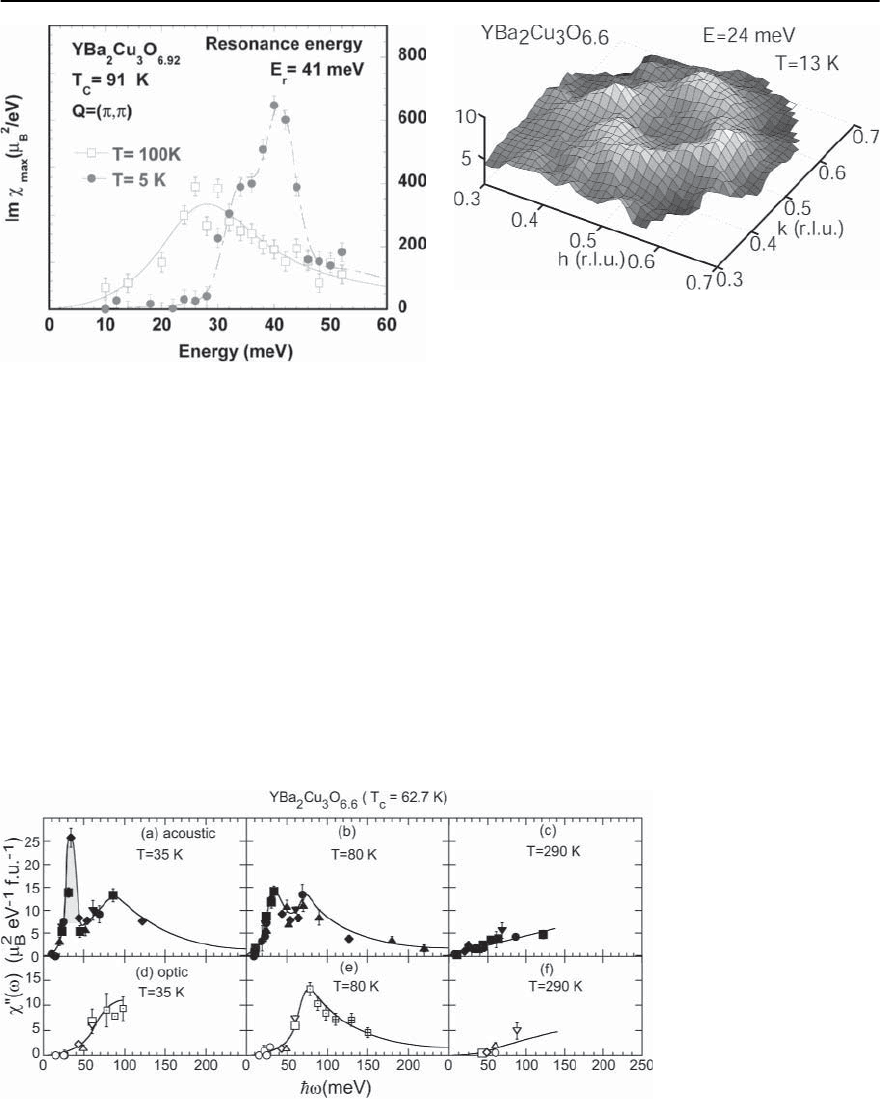
1018 S.M. Hayden
Fig. 18.30. The magnetic response
(Q, !)inthenormal
(open squares) and superconducting (closed circles) state
in YBa
2
Cu
3
O
6.92
. (After Bourges et al.[131])
shows the resonance for optimal doping. For under-
doped compositions a peak in
(q, !)asafunction
of ! develops at the resonance energy above T
c
.This
peak becomes sharper and more intense as the tem-
perature is lowered through T
c
[79,80]. Fig. 18.31
shows data on underdoped YBa
2
Cu
3
O
6.6
illustrating
these points.The resonance has recently been studied
in highly underdoped [82,84] and overdoped [134]
samples. The energy of the (odd) resonance appears
to approximately track T
c
,withE
res
≈ 5.1kT
c
as il-
lustrated in Fig. 18.38.
Fig. 18.32. The incommensurate response in YBa
2
Cu
3
O
6.6
for energies below the resonance (After Mook et al.[135])
It is now clear that the “resonance” is the most
intense part of a mode which disperses downwards
away from (1/2,1/2). The first evidence for the ex-
istence of such a mode was the observation of an
incommensurate structure in wavevector for ener-
gies below the resonance energy [135,136]. Figure
18.32 shows incommensurate scattering measured at
! = 24 meV for underdoped YBa
2
Cu
3
O
6.6
.There
have been several proposals [137–141] for the form
of the dispersion of the resonance mode. Figures
18.33 and 18.34 show early proposals from Arai et
al. [137] and Bourges et al. [138]. There is some de-
bate about the existence of a weaker upward dispers-
ing mode reported by some groups [139,140] but
not others [141]. Figure 18.35 shows an image of the
resonance mode in YBa
2
Cu
3
O
6.6
[141]. The incom-
Fig. 18.31.The odd and even components of the local susceptibility for YBa
2
Cu
3
O
6.6
(After Dai et al. [80])
